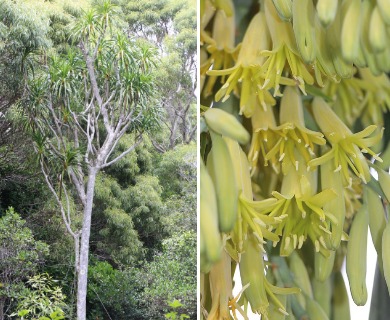Halapepe
Dracaena aurea
Camas/Triteleia/Yucca family (Asparagaceae)
Native species ()
Halapepe ( Pleomele or Dracaena) is a distinctive small tree resembling the related mainland of Yucca, with trunk and very few stout nearly erect branches, ending in a cluster of many crowded large sword-shaped or strap-shaped leaves, not forming a compact Plants are scattered in dry areas on middle slopes of the six large Hawaiian Islands.

©2013 J. B. Friday
Height is about 15–25 ft (4.6–7.6 ), sometimes to 40 ft (12 ). The straight trunk is 1–3 ft (0.3–0.9 ) in diameter, light gray, smooth, slightly scaly or fissured, not divided into bark and wood. The outer dead part is reddish brown and inner part whitish or light yellow with reddish streaks, fibrous, and almost tasteless or slightly bitter. Smallest branches are about 3⁄4–1 1⁄4 inches (2–3 ) in diameter, light gray, smooth with many crowded nearly horizontal lines or ridges of leaf scars, forming rings.
Leaves sword-shaped or strap-shaped, spreading and drooping, 8–20 inches (20–51 ) long and 3⁄8–1 1⁄4 inches (1–3 ) wide, with expanded whitish slightly clasping base, curved, leathery, hairless, ending in long blunt point, slightly shiny green on both surfaces, without not on edges.
Flower clusters () large, massive, about 2 ft (60 ) long at end of leafy branch, curved downward, with stout woody axis, much branched, with leaflike Flowers many, crowded, 1–3 together on slender stalk, narrowly bell-shaped, golden yellow or varying from greenish yellow to orange, about 1 1⁄2–2 inches (4–5 ) long, composed of narrow tube 1 1⁄2 inches (4 ) long and 3⁄8 inch (1 ) wide, six narrow spreading 5⁄8 inch (1.5 ) long, six slender attached near base of and about the same length, and inside enlarged base of tube, composed of rounded greenish 1⁄4 inch (6 ) long, slender long and slightly 3- Flowering in early spring or, in moist areas, summer.
Berries are many on curved stalks, round or slightly 2–3- 3⁄8–5⁄8 inch (1 –1. 5 ) in diameter, bright red, dark brown when dry. Seeds mostly single, sometimes two or three, elliptical or rounded or slightly angled, 1⁄4 inch (6 ) long, whitish or light brown.
The inner portion of trunk corresponding to wood is whitish or light yellow mottled with reddish streaks, fine textured, extremely soft and easily cut. Hawaiians formerly carved religious statues from the soft trunks. The branches served for decorating their altars, including that of Laka, the goddess of hula.
Halapepe is common in dry areas, especially the aa (rough) lava fields through the Hawaiian Islands, usually at 600–2000 ft (183–610 ) altitude). Cultivation of this attractive plant should be encouraged.
Special areas
Kokee, Waimea Arboretum, Wahiawa, Bishop Museum
Champion
Height 20 ft (6.1 ), circumference at breast height 3.5 ft (1. 1 ), spread 14 ft (4.3 ). Kaupulehu, Kailua-Kona, Hawaii (1968).
Range
Native only in Hawaiian Islands.
The common name halapepe, meaning baby hala, refers to the resemblance to the larger plant, hala or screwpine, Pandanus tectorius Parkins.
Botanical
Pleomele aurea (Mann) N. E. Br
The segregate species with distribution by islands are: Dracaena rockii (H.St.John) Jankalski), Molokai and Maui; Dracaena fernaldii (H.St.John) Jankalski, Lanai; Dracaena forbesii (O.Deg.) Jankalski, Oahu; Dracaena halapepe (H.St.John) Jankalski, Oahu; Dracaena konaensis (H.St.John) Jankalski, Hawaii.





